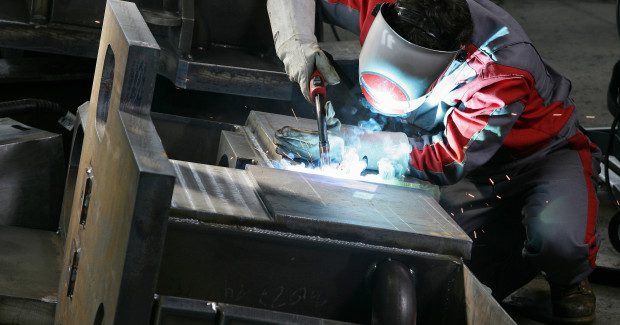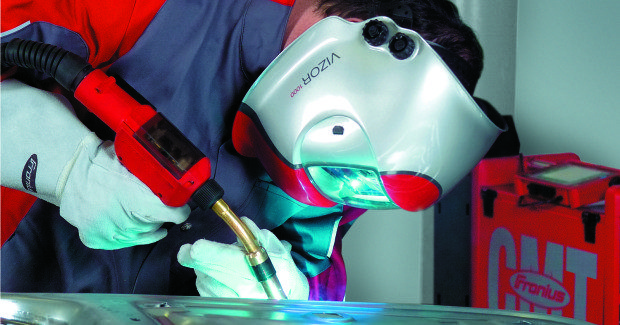Back to Basics: Welding Fume Safety
Though the potential health problems from welding fume exposure can be significant, there are many and varied ways to reduce that risk to almost zero.
Posted: April 30, 2014
A career in welding has higher-than-average health risks than other careers, but welders tend to know the dangers involved and plan for them. They wear gloves, specialized clothing and darkened helmets to protect from burns, debris and arc flash. That should cover things, right?
Not quite.
Scientific studies have shown that welders need to take as much care with the air they breathe as with the protection they wear. Many people in the industry would be surprised at the long list of health problems attributed to breathing welding fumes. Some of those risks include kidney damage, shortness of breath, nausea, lung disease, central nervous system complications, emphysema and even fertility problems.
Luckily, just like a welding shield can prevent eye damage, these risks can be minimized through planning, selecting the proper welding process and ventilation. Understanding the dangers and learning how to assess and prepare the work environment allows welders and their employers to ensure safer, breathable air.
Every type of welding application produces air pollutants in the form of gases and fumes. Fumes are a mixture of metal particles, organic compounds and fine particulates that can be inhaled and trapped in the lungs. The term ‘gas’ refers to a vapor without particulates. Some gases, such as carbon dioxide and argon, are easy for a healthy body to purge without long-term effects. Other gases can be toxic in relatively small doses, such as carbon monoxide, ozone and nitrogen oxides.
An unstable arc can increase the possibility of shielding gas escaping into the air. Both fumes and gases are created through the heating of metals and each are dangerous to inhale. The risks of welding emissions depend on many variables including the type of base and filler metals, coatings, electrodes, flux, shielding gas, the welding process and even the position of the person welding. Since every welding job is specific, changes to certain variables may not be possible. However, even one substitution can lead to cleaner air and better health.
Most often, it’s the welding application that dictates which base metal is used and that leads to defining which filler metals can be utilized. In the majority of welding processes the filler metal is the main source of fume creation. The base metal is less significant unless it contains volatile elements or coatings that aren’t removed before welding.
Some metals produce more dangerous emissions than others. One of the less dangerous toxins can be found in almost all iron and steel welding. The fumes produced contain iron oxides, which, when inhaled, can cause Siderosis, a benign form of lung disease. Symptoms include nose and lung irritation that clears up once exposure has stopped.
Manganese is one of the more dangerous fumes. Though it is an essential nutrient, manganese causes problems when inhaled. It is present is most welding fumes, especially those caused by high-tensile steel welding. A healthy body will rid itself of excess dietary manganese, but inhaled manganese bypasses that system.
Current information shows manganese can cause long-term effects that include damage to the kidneys, lungs, and the central nervous system and can cause fertility problems in men. Short-term effects include “Metal Fume Fever”, a flu-like illness lasting about 24 hours. There is a concern that manganese is linked to Parkinson-like symptoms. The National Institute for Occupation Safety and Health (NIOSH) is conducting research to assess the danger and re-assess safe levels of exposure.
The dangers of breathing welding fumes run the gamut of an occasional cough to serious long-term health problems. Reducing the amount of fume generated is a crucial part of providing a safe welding environment. Choosing the right welding process for the job is standard procedure for any professional. However, certain welding methods actually produce less welding fumes than others. Sometimes there is little choice in which process will produce the best weld for the application, but if possible, consider using a process that generates the least fumes.
In MIG welding (gas metal arc welding, GMAW), the fumes produced are mainly from heating the filler metal. Higher temperatures require more energy for the arc and produce a greater amount of fumes. A lower current/voltage produces less heat and therefore fewer fumes, making short-circuit metal transfer welding an ideal method. However, an unstable arc produces more fumes so be sure to choose a process that provides the best possible arc stability.
TIG welding (tungsten inert gas welding) has been considered one of the safer welding processes when considering fume generation, but recent studies indicate that certain MIG processes can be equally as safe. Multiple studies have shown that GMAW produces significantly less welding fumes than either shielded metal arc welding (SMAW) or flux-cored arc welding (FCAW).
For example, a recent study[1] funded by a division of NIOSH and the Centers for Disease Control and Prevention (CDC) tested 11 different welding processes on mild steel to measure amount of fumes produced. The study included FCAW, SMAW and nine types of GMAW processes from different manufacturers. The published data indicated that, overall, the Cold Metal Transfer (CMT) process by Fronius consistently produced fewer fumes on mild steel than the other tested processes.
This process controls the heat necessary to a minimum though voltage control and wire movement. While this study was conducted solely on mild steel, similar studies are being done on other metals to determine if the heat transference indications remain true. The study concluded by saying, “CMT, pulsed spray, STT[2], and RMD[3] have multiple practical advantages besides low total fume generation rates.” Each of the named processes are considered to be low-heat transfer when compared to other GMAW methods. Being able to choose the welding method that fits the job and produces the least amount of fumes, gives the welder another tool to ensure better air quality.
Since metal has to be heated to weld, there will always be at least a small amount of welding fumes created. The final step in limiting the exposure to this hazard is to remove or filter the contaminated air around the weld. Many options exist to accomplish this from localized filtration to whole shop ventilation systems.
At the weld, pollutants can be removed by utilizing a torch that captures fumes at the arc and removes them to a filtration unit. If welding is often completed in the same location, a downdraft welding table may be an option. These tables pull fumes down and away from the weld while providing a stable dedicated work area. If welding occurs in varied areas, a hood style unit that vacuums the air around the weld into a small filter might be more ideal.
Sometimes the entire shop will benefit from a filtration system. These systems constantly scrub the air and provide clean fresh air to the whole shop. If there isn’t a system in place to remove fumes, there are still options to consider, including wearable ventilation hoods and respirators. If nothing else, make sure welding occurs in a well ventilated area and that the welder doesn’t stand directly over the weld. Warm fumes rise upwards so make sure that the breathing space isn’t in line above the weld.
Though the potential health problems from welding fume exposure can be significant, there are many and varied ways to reduce the risk to almost zero. Assess the welding requirements to understand how well each option will work. Choose the best process for the job, understand how filler metals can affect air quality, and be sure ventilation is appropriate to the work area. By considering all of these factors and acting to provide the cleanest air possible, you can ensure that you and your fellow welders are striking arcs for years to come.
References
- Fact Sheet: Controlling Hazardous Fume and Gases during Welding Published by OSHA.gov https://www.osha.gov/Publications/OSHA_FS-3647_Welding.pdf
- Facts About Fume & Gases published by AGA http://www.aga.com/international/web/lg/aga/like35agacom.nsf/repositorybyalias/facts_fume_gases_uk/$file/AGA%20Fume%20Gases%20Facts%20About%20UK.pdf
- Profiling Mild Steel Welding Processes to Reduce Fume Emissions and Costs in the Workplace by Michael J. Keane, et all. Published by Oxford University Press
- Welding & Manganese: Potential Neurologic Effects published by CDC.gov http://www.cdc.gov/niosh/topics/welding/
- Workplace Health and Safety Bulletin: Welder’s Guide to the Hazards of Welding Gases and Fumes Published by Work Safe Alberta
[1] Profiling Mild Steel Welding Processes to Reduce Fume Emissions and Costs in the Workplace by Michael J. Keane, et all. Published by Oxford University Press.
[2] Surface Tension Transfer GMAW process by Lincoln Electric
[3] Regulated Metal Deposition GMAW process by Miller Electric













